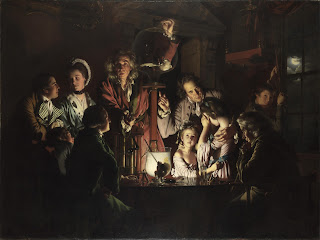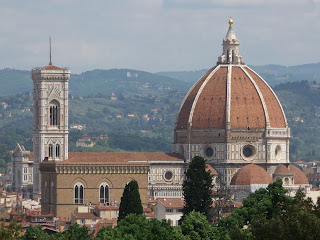Science as a Focal Point in Classicism Art
Alongside these developments, exploration of the world led to the discovery of Pompeii. The horror preserved there reignited interest in antiquity. The art of Rome and Greece began influencing the artwork once again. However, one of the notable changes was rather than idealized forms, flaws of the human subject were allowed to be captured instead.
The pieces I will be looking at show influences of antiquity from clothing, hairstyles, and mythology as well as the influence science has shaped the society of the 1700s.
Artist: Joseph Wright of Derby
Circa: 1768
Location Liverpool, London
Image hosted by: https://en.wikipedia.org/
The picture above is a perfect example of the focus of science in the 1700s. We see a group of people observing an example of what would happen to a bird if deprived of air. The person running the experiment uses an air pump to produce these results. While the air pump and bird are the focus of the work, the people observing enforce the importance of science and reason. As we look at the expressions and emotions around the table, we notice that even though an animal is being killed for this experiment most of the group cannot look away. They are fascinated by what they see here. The idea of death has moved to the back of their minds. Then we have the one who has looked away out of shock or sadness. The man next to her tries to convince her the importance of this work.This piece uses light and dark beautifully here to focus our eyes on the air pump and the experiment. Darkness closes in on the circle of people. Their bodies that face the experiment are the only things where light is prevalent. Many textures are displayed in the center of this picture. We can easily see the folds of their clothes, the roughness of the coats, the flow of their hair, and the fluff of the feathers of the dying bird. Another interesting aspect to me is while depth is implied heavily by overlapping and shading, the core of this group lies on one horizontal line in the center of this painting. Everything above and below this line starts to fade into obscurity. This was a key technique in classicism artwork.
The Alchemists
Artist: Pietro Longhi
Circa: 1757
Location:
Like the first painting, The Alchemists focuses on the practice of alchemy. Alchemy itself is a debunked science now, we still see the connections it would have with chemistry and medicine. In this image, I can see those foundations with the tools that are used. Without the flasks, books, and other varied tools in use here, the alchemists would just be three men in a room.
When looking at this painting, the color is the first thing that jumps out to me. Dull colors create an atmosphere of focus and study. There is also very little use of shading used. The lit environment is imperative when conducting research. I also see the clever use of shapes in this image. All three alchemist's bodies are comprised of a triangle. From the right, we have the hem of the alchemist's robe to the top of his head. The middle alchemist has two triangles. An inverted triangle is formed from the overlap from the alchemist on the right and left. While his arms form the base. Now from the arms as a base once again to the top of his head we see another triangle. Next, the alchemist on the left is hunched over. This position allows us to use the hem of his robe as the base to the top of his robe as the point. Each triangle leads us to different points of the room. Each triangle pulls us to the tools scattered around the room. Lastly, we notice that the alchemists, like the observers in the previous painting are sitting on one horizontal line.
I feel like this painting should be seen among other historical works. Even though the painting is a depiction of science, it emanates an art history feel due tot he composition of colors and shapes.
A Pregnant Woman, Dissected, Lateral View, with Arms Upraised, Accompanied by Separate Sections of the Body
Artist: Jacques-Fabien Gautier D'Agoty
Circa: 1764-65
Location: Dijon, France
Image hosted by: https://artuk.org/
This painting is one of the many anatomical pieces down by Jacques-Fabien Gautier D'Agoty. Jacques-Fabian was a member of the Academy of Dijon, a collection of scholars. This painting's focus shifts the importance of tools to scientific knowledge of anatomy. We have a woman as the focal point and her body is shown as different parts of human anatomy. As we work inwards toward the center her skin is changed to that of strands of muscle and ends with the view inside her abdomen of a child in the fetal position. We can also see the dissection of other bodies and organs at her feet. This painting is a direct link to science's impact on the subject. The study of anatomy introduce the knowledge Jacques-Fabian needed to compose this painting.
"Enlightenment | Definition, Summary, Ideas, Meaning, History, Philosophers, & Facts". Encyclopedia Britannica, 2022, https://www.britannica.com/event/Enlightenment-European-history.
"Enlightenment Summary". Encyclopedia Britannica, 2022, https://www.britannica.com/summary/Enlightenment-European-history.
"Wright Of Derby, A Philosopher Lecturing On The Orrery (Article) | Khan Academy". Khan Academy, 2022, https://www.khanacademy.org/humanities/renaissance-reformation/britain-18c/britain-ageof-revolution/a/wright-of-derby-a-philosopher-lecturing-on-the-orrery.
""An Experiment On A Bird In The Air Pump" By Joseph Wright Of Derby – Joy Of Museums Virtual Tours". Joy Of Museums Virtual Tours, 2022, https://joyofmuseums.com/museums/united-kingdom-museums/london-museums/the-national-gallery-london/masterpieces-of-the-national-gallery/an-experiment-on-a-bird-in-the-air-pump-by-joseph-wright-of-derby/.
"The Roots Of Chemistry: How The Ancient Tradition Of Alchemy Influenced Modern Scientific Thought". The Aggie Transcript, 2022, https://aggietranscript.ucdavis.edu/the-roots-of-chemistry-how-the-ancient-tradition-of-alchemy-influenced-modern-scientific-thought/.
"Jacques Fabien Gautier D'agoty - Wikipedia". En.Wikipedia.Org, 2022, https://en.wikipedia.org/wiki/Jacques_Fabien_Gautier_d%27Agoty.
"A Pregnant Woman, Dissected, Lateral View, With Arms Upraised, Accompanied By Separate Sections Of The Body | Art UK". Artuk.Org, 2022, https://artuk.org/discover/artworks/a-pregnant-woman-dissected-lateral-view-with-arms-upraised-accompanied-by-separate-sections-of-the-body-125907.






The piece that you posted “A Pregnant Woman, Dissected, Lateral View, with Arms Upraised, Accompanied by Separate Sections of the Body by Jacques-Fabien Gautier D'Agoty” was my favorite piece that you showed.This artist has a lot of knowledge about human anatomy. This piece is definitely related to science and discovery. What I found insightful about this piece is the texture of the muscles and how they pull and attach in the correct places. This artist had to have seen a dissected body. The look of the muscles is just too spot on for the artist not to have seen some human anatomy. The accuracy of the way the baby is inside the womb also anatomically correct. The baby is in the correct position and the umbilical cord is also accurately depicted. The vaginas and uterus parts at the bottom of the painting are interesting. This piece seems very medical like it could be out of a 1700’s medical book. I love anatomy but this piece belongs in a medical office or museum not a home. I find it very interesting to look at and to see what people understood about the human body in the 1700’s.
ReplyDeleteYour second painting is also very interesting.
I also reviewed the painting An Experiment On a Bird With An Air Pump. It looks like another classmate did also. I love the candle light view in this painting. Good taste, we reviewed the same piece so I was of course going to like it.
The last review of The Alchemist painting did not interest me. It just didn’t capture my interest. It lacked depth and color. I was also left wondering what it was about by just looking at it. After reading your review I figured it out but it just doesn’t capture my attention.
All of your selections were influenced by art and scientific discovery. Additionally, I really like the colors and background pictures on your blog. Great job setting that up.
You did a great job connecting the art you chose to the theme of science. The first piece is so eerie, the one thing I seem to gravitate to when looking at art is when the artist uses different tones to create the idea of light. It looks so simple, but the skill and technique needed to create a shadow cast by light are great. That first piece just has a creepy, advanced feel to it. As if it was made earlier than you'd expect.
ReplyDeleteI also really like the last piece of the pregnant woman who is dissected laterally. For the time period, it seems so scientifically accurate. Since we are still coming out of a time where the church is very prevalent in daily life and beliefs, it is so neat to see science taking the forefront.